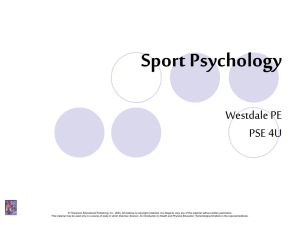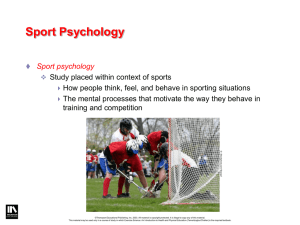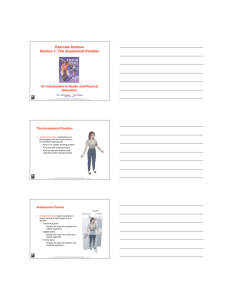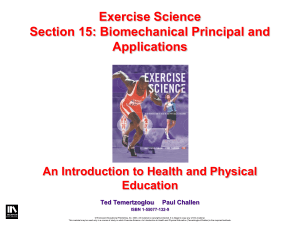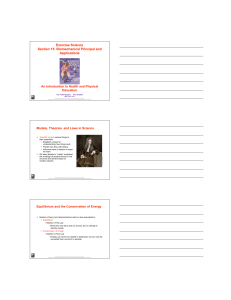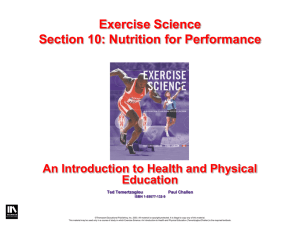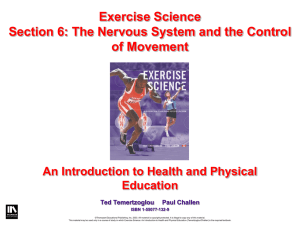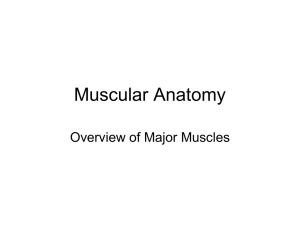File
advertisement
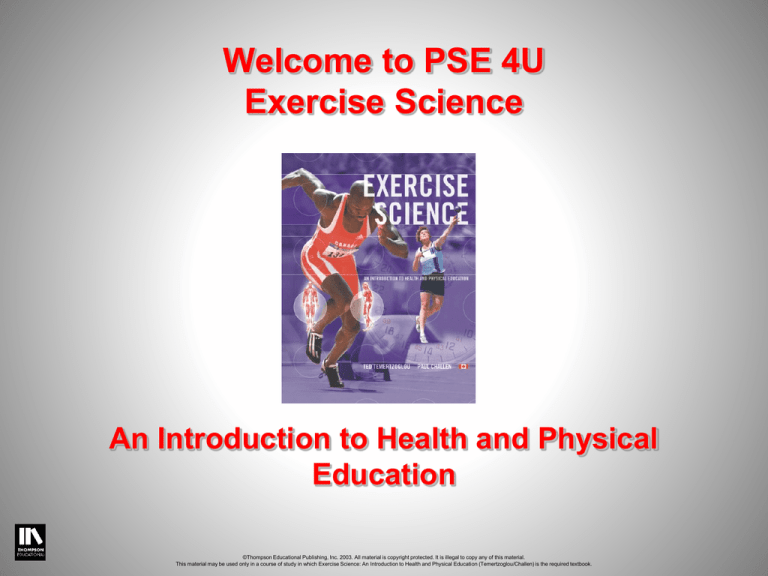
Welcome to PSE 4U Exercise Science An Introduction to Health and Physical Education ©Thompson Educational Publishing, Inc. 2003. All material is copyright protected. It is illegal to copy any of this material. This material may be used only in a course of study in which Exercise Science: An Introduction to Health and Physical Education (Temertzoglou/Challen) is the required textbook. DAY 1 I know why I am here….. Why are you here?? Schools ©Thompson Educational Publishing, Inc. 2003. All material is copyright protected. It is illegal to copy any of this material. This material may be used only in a course of study in which Exercise Science: An Introduction to Health and Physical Education (Temertzoglou/Challen) is the required textbook. DAY 1 • Textbook • Workbook ©Thompson Educational Publishing, Inc. 2003. All material is copyright protected. It is illegal to copy any of this material. This material may be used only in a course of study in which Exercise Science: An Introduction to Health and Physical Education (Temertzoglou/Challen) is the required textbook. DAY 1 • Assessment/Evaluation Policy • Course Outline • Student Website • Website: http://thompsonbooks.com/exercisescience/ • Username:studentES • Password: exsci1234 ©Thompson Educational Publishing, Inc. 2003. All material is copyright protected. It is illegal to copy any of this material. This material may be used only in a course of study in which Exercise Science: An Introduction to Health and Physical Education (Temertzoglou/Challen) is the required textbook. DAY 1 • Expectations Attendance Homework Studying Communication “With increased freedom comes the need for increased responsibility!” ©Thompson Educational Publishing, Inc. 2003. All material is copyright protected. It is illegal to copy any of this material. This material may be used only in a course of study in which Exercise Science: An Introduction to Health and Physical Education (Temertzoglou/Challen) is the required textbook. Learning Objectives for Chapter 1 • • • • • • Basic terminology of anatomy and physiology The anatomical position Anatomical planes Anatomical axes Basic movements involving joints The ten biological systems of the human body ©Thompson Educational Publishing, Inc. 2003. All material is copyright protected. It is illegal to copy any of this material. This material may be used only in a course of study in which Exercise Science: An Introduction to Health and Physical Education (Temertzoglou/Challen) is the required textbook. Basic Terms: Anatomy: branch of science that deals with the structural organization of living things-how they are “built” and what they consist of. -usually studied in conjunction with physiology: Physiology: concerned with basic processes such as reproduction, growth, and metabolism as they occur within the various systems of the body. Anatomy is concerned with the structure of the body and its various organs, and physiology is the study of how all these parts function. ©Thompson Educational Publishing, Inc. 2003. All material is copyright protected. It is illegal to copy any of this material. This material may be used only in a course of study in which Exercise Science: An Introduction to Health and Physical Education (Temertzoglou/Challen) is the required textbook. Exercise Physiology: • Concentrates their research specifically on how the body responds and adapts to the stresses placed on it by exercise. ©Thompson Educational Publishing, Inc. 2003. All material is copyright protected. It is illegal to copy any of this material. This material may be used only in a course of study in which Exercise Science: An Introduction to Health and Physical Education (Temertzoglou/Challen) is the required textbook. What is the Anatomical Position? The anatomical position is: “the universally accepted starting point used to describe or analyze anatomical terms or movement.” To be in correct anatomical position, the body must meet 3 criteria: 1. Upright, standing position 2. Face and feet pointing forward 3. Arms at the side, palms facing forward But how do we use the anatomical position to describe movement? ©Thompson Educational Publishing, Inc. 2003. All material is copyright protected. It is illegal to copy any of this material. This material may be used only in a course of study in which Exercise Science: An Introduction to Health and Physical Education (Temertzoglou/Challen) is the required textbook. Before looking specifically at movement, we first have to understand how to describe movement. By the end of this lesson you will be introduced to 3 concepts: 1. Planes 2. Axes 3. Position You will be learning and expected to use a new language from here on in! ©Thompson Educational Publishing, Inc. 2003. All material is copyright protected. It is illegal to copy any of this material. This material may be used only in a course of study in which Exercise Science: An Introduction to Health and Physical Education (Temertzoglou/Challen) is the required textbook. Anatomical Planes -relate to positions in space and found at right angles to each other -these planes can be positioned on any specific parts of the body Frontal(Coronal) -vertical; divides the body into front (anterior) and back (posterior) segments ©Thompson Educational Publishing, Inc. 2003. All material is copyright protected. It is illegal to copy any of this material. This material may be used only in a course of study in which Exercise Science: An Introduction to Health and Physical Education (Temertzoglou/Challen) is the required textbook. Frontal section of the human face Anatomical Planes -relate to positions in space and found at right angles to each other -these planes can be positioned on any specific parts of the body Frontal(Coronal) -vertical; divides the body into anterior and posterior segments Sagittal(median) -vertical; divides the body into left and right segments (or medial and lateral segments) ©Thompson Educational Publishing, Inc. 2003. All material is copyright protected. It is illegal to copy any of this material. This material may be used only in a course of study in which Exercise Science: An Introduction to Health and Physical Education (Temertzoglou/Challen) is the required textbook. Sagittal view of the human face Anatomical Planes -relate to positions in space and found at right angles to each other -these planes can be positioned on any specific parts of the body Frontal(Coronal) -vertical; divides the body into anterior and posterior segments Sagittal -vertical; divides the body into medial and lateral segments Transverse -horizontal; divides the body into upper (superior) and lower(inferior) segments ©Thompson Educational Publishing, Inc. 2003. All material is copyright protected. It is illegal to copy any of this material. This material may be used only in a course of study in which Exercise Science: An Introduction to Health and Physical Education (Temertzoglou/Challen) is the required textbook. Anatomical Axes -axes are used to describe the direction of movement at joints - much of our movement occurs via our joints Longitudinal -vertical; extends superior (head) to inferior (foot) Antero-posterior -rotate around -extends from front to back -north-south relationship to anatomical position -rotate side to side -front-back relationship Horizontal - runs from one side of the body to the other -rotate top to bottom- east-west relationship to anatomical position ©Thompson Educational Publishing, Inc. 2003. All material is copyright protected. It is illegal to copy any of this material. This material may be used only in a course of study in which Exercise Science: An Introduction to Health and Physical Education (Temertzoglou/Challen) is the required textbook. Finding Axes and Planes A body movement can be described in terms of the anatomical plane through which it occurs and the anatomical axis around which it rotates Axis of rotation is always perpendicular to the plane of movement In the anatomical position: all flexion/extension occurs in the sagittal plane, all abduction/adduction occurs in the frontal plane, and all rotation occurs in the transverse plane More involved movements usually occur as a combination of motions from more than one plane Longitudinal Axis 90 Transverse Plane ©Thompson Educational Publishing, Inc. 2003. All material is copyright protected. It is illegal to copy any of this material. This material may be used only in a course of study in which Exercise Science: An Introduction to Health and Physical Education (Temertzoglou/Challen) is the required textbook. o Relationship Between Axes and Planes Axis of Rotation Plane of Motion Example Horizontal (Bilateral) Sagittal Flexion/Extension Longitudinal (Polar) Transverse Rotation of extremities/Axial rotation Antero-Posterior Frontal Abduction/Adduction ©Thompson Educational Publishing, Inc. 2003. All material is copyright protected. It is illegal to copy any of this material. This material may be used only in a course of study in which Exercise Science: An Introduction to Health and Physical Education (Temertzoglou/Challen) is the required textbook. Helpful Videos https://www.youtube.com/watch ?v=UsZwsjGuDxU ©Thompson Educational Publishing, Inc. 2003. All material is copyright protected. It is illegal to copy any of this material. This material may be used only in a course of study in which Exercise Science: An Introduction to Health and Physical Education (Temertzoglou/Challen) is the required textbook. Twirling What is the axis of rotation? Longitudinal What is the plane of motion? Transverse ©Thompson Educational Publishing, Inc. 2003. All material is copyright protected. It is illegal to copy any of this material. This material may be used only in a course of study in which Exercise Science: An Introduction to Health and Physical Education (Temertzoglou/Challen) is the required textbook. Task – get into 5 groups and determine the Axis and Plane for each movement Action Axis Plane Stride Jump Cart Wheel Elbow Extension Nodding Head ‘Yes’ Shaking Head ‘No’ ©Thompson Educational Publishing, Inc. 2003. All material is copyright protected. It is illegal to copy any of this material. This material may be used only in a course of study in which Exercise Science: An Introduction to Health and Physical Education (Temertzoglou/Challen) is the required textbook. Various Planes of Movement Action Axis Plane Stride Jump Antero-Posterior Frontal Cart Wheel Antero-Posterior Frontal Elbow extension Horizontal Sagittal Nodding head “yes” Horizontal Sagittal Shaking head “no” Longitudinal Transverse ©Thompson Educational Publishing, Inc. 2003. All material is copyright protected. It is illegal to copy any of this material. This material may be used only in a course of study in which Exercise Science: An Introduction to Health and Physical Education (Temertzoglou/Challen) is the required textbook. Describing Position and Movement Anterior: front surface of the body Posterior: back surface of the body Superior: refers to structures being closer to the top of the body (excluding limbs) Inferior: refers to structures being closer to the lower part of the body (excluding limbs) Medial: towards the midline Lateral: away from the midline Proximal: towards the upper segment of a limb Distal: towards the lower segment of a limb ©Thompson Educational Publishing, Inc. 2003. All material is copyright protected. It is illegal to copy any of this material. This material may be used only in a course of study in which Exercise Science: An Introduction to Health and Physical Education (Temertzoglou/Challen) is the required textbook. Basic Movements Involving a Joint Use the information from the following slides to complete Workbook Exercise 1.3 – Pg.15 ©Thompson Educational Publishing, Inc. 2003. All material is copyright protected. It is illegal to copy any of this material. This material may be used only in a course of study in which Exercise Science: An Introduction to Health and Physical Education (Temertzoglou/Challen) is the required textbook. The Basic Movements of the Human Body The basic movements of the human body occur around and because of our joints. You are expected to start using these terms frequently, because no longer do you “bend”, you “flex”. “Rolling” your ankle becomes an ankle “inversion”. And “pointing” your toe, will now be referred to as “plantar flexion” Flexion -bending the joint to reduce the angle between two bones. -occurs in the sagittal plane Extension -straightening a joint to increase the angle -occurs in the sagittal plane ©Thompson Educational Publishing, Inc. 2003. All material is copyright protected. It is illegal to copy any of this material. This material may be used only in a course of study in which Exercise Science: An Introduction to Health and Physical Education (Temertzoglou/Challen) is the required textbook. ©Thompson Educational Publishing, Inc. 2003. All material is copyright protected. It is illegal to copy any of this material. This material may be used only in a course of study in which Exercise Science: An Introduction to Health and Physical Education (Temertzoglou/Challen) is the required textbook. Abduction -movement away from the midline of the body -occurs in the frontal plane Adduction -movement towards the midline of the body -occurs in the frontal plane Circumduction -a circular motion combining flexion, extension, abduction and adduction -occurs in all 3 planes ©Thompson Educational Publishing, Inc. 2003. All material is copyright protected. It is illegal to copy any of this material. This material may be used only in a course of study in which Exercise Science: An Introduction to Health and Physical Education (Temertzoglou/Challen) is the required textbook. ©Thompson Educational Publishing, Inc. 2003. All material is copyright protected. It is illegal to copy any of this material. This material may be used only in a course of study in which Exercise Science: An Introduction to Health and Physical Education (Temertzoglou/Challen) is the required textbook. Internal (Medial) Rotation -moves anterior part of a limb medially (towards midline) -occurs in the transverse plane External (Lateral) Rotation -moves anterior part of a limb laterally (away from midline) -occurs in the transverse plane Pronation -rotation of hand; bring thumb towards midline; palm facing back -occurs in transverse plane Supination -rotation of hand; bring thumb away from midline; palm facing forward -occurs in transverse plane ©Thompson Educational Publishing, Inc. 2003. All material is copyright protected. It is illegal to copy any of this material. This material may be used only in a course of study in which Exercise Science: An Introduction to Health and Physical Education (Temertzoglou/Challen) is the required textbook. ©Thompson Educational Publishing, Inc. 2003. All material is copyright protected. It is illegal to copy any of this material. This material may be used only in a course of study in which Exercise Science: An Introduction to Health and Physical Education (Temertzoglou/Challen) is the required textbook. Dorsiflexion -movement of ankle to decrease angle between foot and lower leg -occurs in sagittal plane Plantarflexion -movement of ankle to increase angle between foot and lower leg -occurs in sagittal plane Inversion -medial border of foot is raised; sole of foot turned medially (inward) -occurs in frontal plane Eversion -lateral border of foot raised; sole of foot turned laterally (outward) ©Thompson Educational Publishing, Inc. 2003. All material is copyright protected. It is illegal to copy any of this material. This material may be used only in a course of study in which Exercise Science: An Introduction to Health and Physical Education (Temertzoglou/Challen) is the required textbook. ©Thompson Educational Publishing, Inc. 2003. All material is copyright protected. It is illegal to copy any of this material. This material may be used only in a course of study in which Exercise Science: An Introduction to Health and Physical Education (Temertzoglou/Challen) is the required textbook. Protraction -moving in an anterior (forward) direction -occurs in sagittal plane Retraction -moving in a posterior (backward) direction -occurs in sagittal plane Oppostion -thumb comes into contact with another finger Reposition -return thumb to anatomical position ©Thompson Educational Publishing, Inc. 2003. All material is copyright protected. It is illegal to copy any of this material. This material may be used only in a course of study in which Exercise Science: An Introduction to Health and Physical Education (Temertzoglou/Challen) is the required textbook. Elevation -raising up to a more superior position -occurs in frontal plane Depression -pulling down to a more inferior position -occurs in frontal plane ©Thompson Educational Publishing, Inc. 2003. All material is copyright protected. It is illegal to copy any of this material. This material may be used only in a course of study in which Exercise Science: An Introduction to Health and Physical Education (Temertzoglou/Challen) is the required textbook. Homework • Complete exercise 1.2 pg. 12-14 & exercise 1.4 page 16. • Quiz Next Class ©Thompson Educational Publishing, Inc. 2003. All material is copyright protected. It is illegal to copy any of this material. This material may be used only in a course of study in which Exercise Science: An Introduction to Health and Physical Education (Temertzoglou/Challen) is the required textbook.
